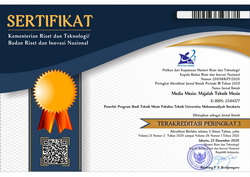RANCANG BANGUN MOLD UNTUK PROSES TERMOFORMING PROSTHETIC BELOW KNEE (B/K)
Bambang Waluyo Febriantoko(1*), Aris Aryanto(2), Tri Widodo Besar Riyadi(3)(1) Universitas Muhammadiyah Surakarta
(2) Universitas Muhammadiyah Surakarta
(3) Universitas Muhammadiyah Surakarta
(*) Corresponding Author
Abstract
ABSTRAK
Industri semakin berkembang, kebutuhan terhadap plastik pun semakin bertambah. Akan tetapi, dalam aplikasi proses pembentukan plastik sering mengalami kendala. Salah satunya adalah penyusutan. Penyusutan sering terjadi pada proses pembentukan plastik, terutama pembentukan dengan sistem mechanical thermoforming. Sehingga perlu dianalisis hal-hal yang menyebabkan penyusutan pada produk yang dihasilkan. Beberapa hal yang diidentifikasi mempengaruhi terjadinya penyusutan adalah bentuk mold, temperatur, dan jenis plastik yang digunakan.
Metode penelitian yang digunakan adalah membuat alat uji mechanical thermoforming dan membuat mold yang akan digunakan untuk menganalisis penyusutan. Mold yang digunakan ada 2 macam, yaitu mold telapak kaki atas dan mold telapak kaki bawah. Selain variasi pada mold, analisis juga ditujukan pada temperatur plastik polypropylene (PP) dan plastik PVC yang akan diproses. Variasi temperatur yaitu:
1000C, 1200C, dan 140oC. Sedangkan jenis plastik yang diujikan adalah plastik
polypropylene (PP) dan plastik PVC.
Dari data hasil pengujian dan pembahasan pada proses mechanical thermoforming untuk plastik polypropylene (PP) dengan ketebalan 1,0 mm tidak dapat dianalisis persentase penyusutan yang terjadi karena sifat viskos pada plastik rendah. Pada plastik jenis PP ini meskipun membentuk pola, tetapi tidak sempurna. Bahan plastik PP setelah proses penekanan dengan temperatur 100ºC-120ºC plastik tidak mengalami pemuaian yang cukup baik, karena plastik masih bersifat elastik. Pada temperatur
140ºC plastik mengalami pemuaian, tetapi saat proses penekanan plastik mengalami bentuk pola yang tidak sempurna, karena temperatur terlalu tinggi. Sedangkan pada plastik PVC didapatkan hasil bahwa pada mold telapak kaki atas dengan ketinggian
2 cm dan tebal plastik 1,0 mm menghasilkan persentase penyusutan rata-rata 7,85% dengan temperatur 100ºC, 9,80% dengan temperatur 120ºC dan 12,11% dengan temperatur 140ºC. Pada mold telapak kaki bawah dengan ketinggian 2 cm dan tebal plastik 1,0 mm menghasilkan persentase penyusutan rata-rata 10,01% dengan temperatur 100ºC, 10,96% dengan temperatur 120ºC dan 12,08% dengan temperatur
140ºC.
Kata Kunci: Mechanical thermoforming, penyusutan plastik, mold
ABSTRACT
The growing of industry has the effect to the increase of plastic need. However, the application of plastic forming process often experiences constraints. One of them is depreciation. Depreciation often occurs in the plastic forming process, especially forming with mechanical thermoforming system. So it is necessary to analyze the things that cause shrinkage on the product. Some of the things that are identified to influence the shrinkage are the molds, temperatures and types of used plastics.
The used method is to make mechanical thermoforming test and make mold which will be used to analyze depreciation. There are 2 kinds of molds, namely upper foot sole mold and bottom foot sole mold. In addition to the variations of the mold, the analysis is also aimed at the temperature of polypropylene plastic (PP) and PVC plastic which will be processed. The temperature variations are 1000C, 1200C and 140oC and the types of plastics that are tested is polypropylene plastic (PP) and PVC plastic.
The results show that on mechanical thermoforming process for polypropylene (PP) plastic with 1.0 mm thickness, the percentage of shrinkage can not be analyzed because of the low viscous nature of plastic. PP type plastic can form a pattern, but not perfect. PP plastic material does not experience a good expansion after pressing process with
100ºC-120ºC plastic temperature. This is because the plastic is still elastic. At 140ºC, the plastic undergoes expansion, but when the plastic pressing process, it undergoes an imperfect pattern. The reason is the temperature is too high. Meanwhile for the PVC plastic, it was found that in the upper foot sole mold with height of 2 cm and 1.0 mm plastic thickness, the percentages of shrinkage average are 7.85% with temperature
100ºC, 9.80% with temperature 120ºC and 12.11% with temperature of 140ºC. In the bottom foot sole mold with 2 cm height and 1.0 mm plastic thickness, the percentages of shrinkage average are 10.01% with temperature 100ºC, 10.96% with temperature
120ºC and 12.08% with temperature 140ºC.
Keywords: Mechanical thermoforming, plastic shrinkage, mold
Full Text:
PDFReferences
Herdiman, L., 2007. Pengembangan Karakteristik Fungsi Prothese Kaki Jenis Above Knee Amputation dengan Teknologi Computer Aided Engineering (CAE). Surakarta: Universitas Sebelas Maret.
Suryono, A.F., 2007. Kajian dalam Pegembangan Rancangan Sach Foot Pengguna Prothese Jenis Below Knee Amputation Berdasarkan Penekanan Biomekanika. Surakarta: Universitas Sebelas Maret.
Combe, E.C., 1992. Pembuatan Cetakan dari Gypsum. Diakses 15 Juni 2009 dari www. google.com/gypsum
Bralla, James, G., 1998. Design for Manufacturability Handbook. McGraw-Hill
Companies.
Groover, M. P., 1996. Fundamentals of Modern Manufacturing Materials Processes
and Svstem, Prentice-Hall.
Kalpakjian, Serope and Steven R. Schmid, 2003. Manufacturing Process for Engineering
Materials, fourh Edition. lllinois Institute of Technology, Chicago.
Ma’arif, S., 2009. Analisis Warpage Pada Lembaran Plastik Polyethylene (PE) dan Polypropylene (PP) Hasil Proses Vacum Thermoforming. Surakarta: Universitas Muhammadiyah Surakarta.
Schey, J. A., 2000. Introduction to Manufacturing Process, McGraw Hill.
Saito, S., Surdia, T., 1999. Pengetahuan Bahan Teknik. PT. Pradnya Paramita, Jakarta.
Smith, William F. and Javad Hashemi, 2006. Foundations of Materials science and
Engineering, McGraw Hill.
Article Metrics
Abstract view(s): 983 time(s)PDF: 1002 time(s)
Refbacks
- There are currently no refbacks.








